Some Codon Optimized Genes Are Better Than Others
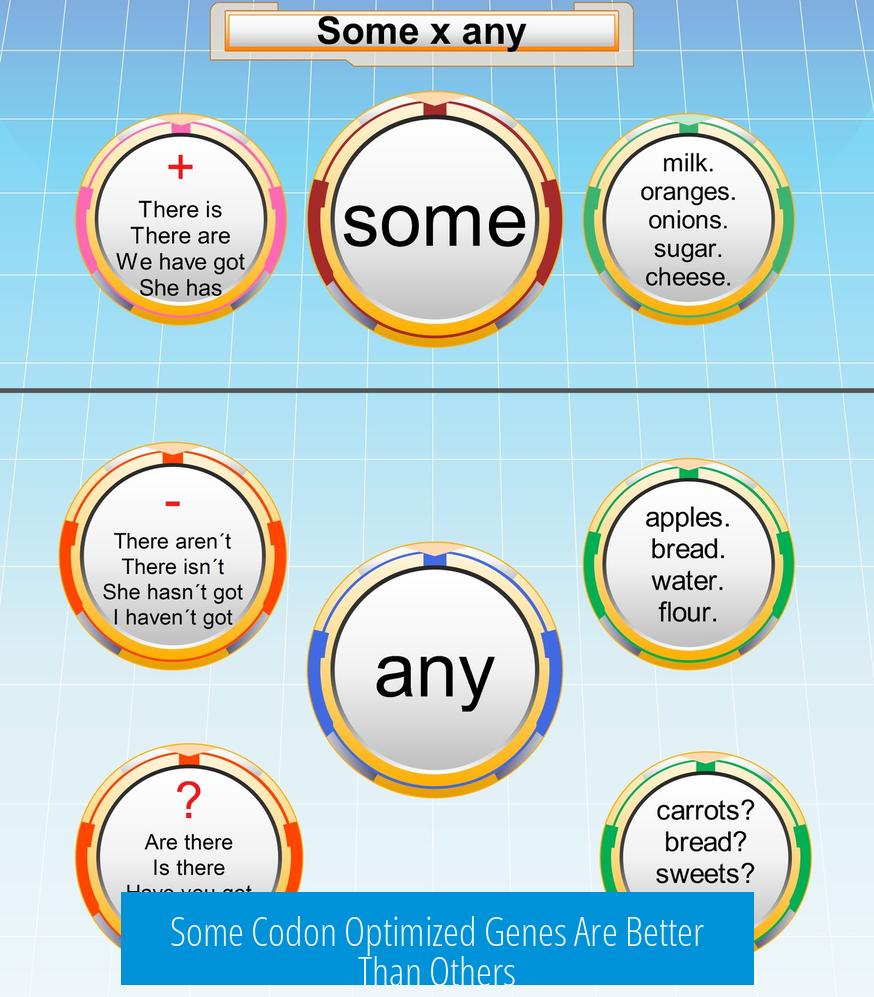
Codon-optimized genes differ in their performance due to the complexity of gene expression, which depends on various factors beyond simple codon frequency. Optimization algorithms, mRNA secondary structure, transcriptional effects, and host-specific conditions all influence expression efficiency. Thus, some codon-optimized genes yield better protein production than others.
Variability in Codon-Optimized Gene Performance
Codon optimization aims to improve gene expression by matching the codon usage to that preferred by the host organism, such as E. coli. However, users report that results from different providers vary significantly. For instance, GenScript uses advanced algorithms that consider mRNA secondary structure, which appears important for expression success.
Other providers like IDT, Thermo, and Genewiz focus heavily on codon frequency or sequence synthesis ease, which may not fully capture all influencing factors. The variability observed reflects the fact that not all codon optimization methods weigh critical factors equally.
- GenScript includes mRNA secondary structure in optimization, improving expression outcomes.
- Some companies simply replace rare codons with common ones without structural considerations.
- Algorithms differ in how they balance codon frequency, GC content, and sequence complexity.
Factors Beyond Codon Usage Affecting Gene Expression Efficiency
mRNA Secondary Structure Impact
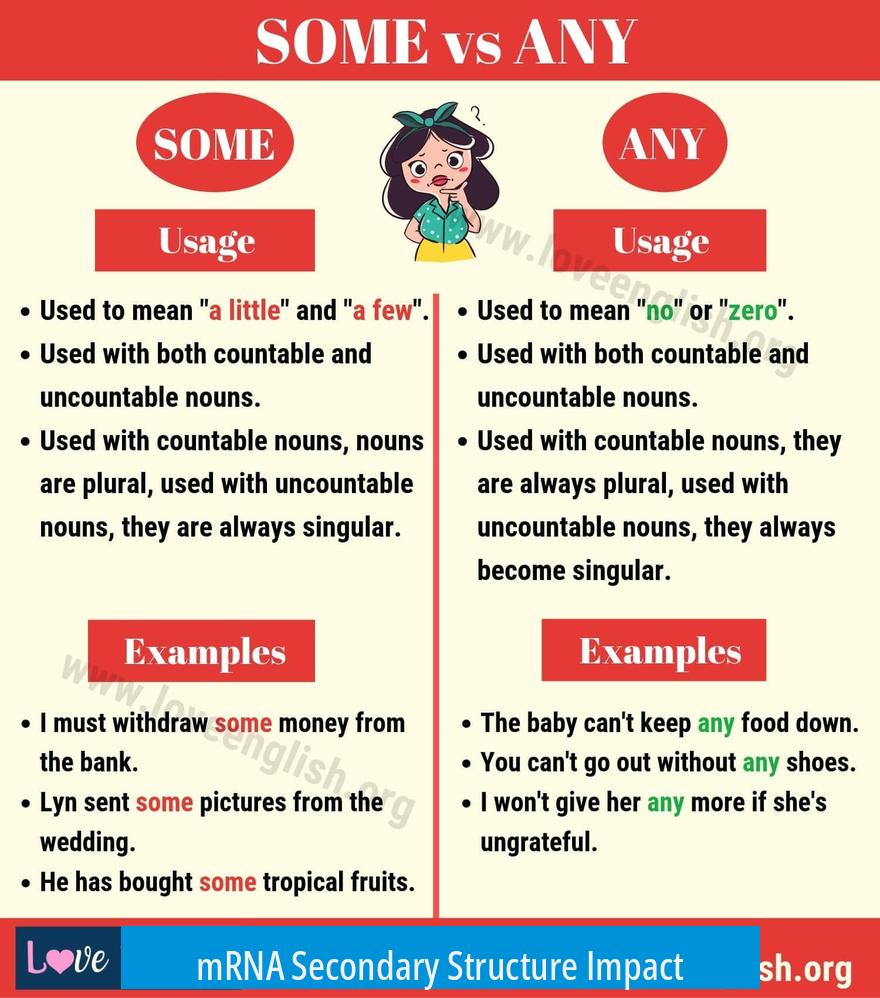
mRNA structure is a pivotal factor in gene expression. Secondary structures near the 5′ end influence translation initiation and mRNA stability, thus affecting protein yield. Strong folding or hairpins close to the ribosome-binding site can inhibit translation efficiency.
Laboratories like the Salis lab highlight that the folding landscape near the mRNA’s start site matters more than merely avoiding rare codons. Stable secondary structures can reduce mRNA half-life and limit ribosome access.
Transcriptional-Level Effects
Gene expression is also subject to transcriptional controls. Sometimes, unintended DNA motifs introduced by optimization can recruit repressors or other regulatory proteins that impair transcription. These effects are less commonly addressed during codon optimization.
Tools that analyze DNA motifs relevant to transcriptional regulation exist but are not widely integrated into standard codon optimization pipelines. Thus, optimization that ignores DNA-level regulatory elements can yield unpredictable expression.
Codon Usage and CAI Limitations
Codon Adaptation Index (CAI) measures how well codon usage matches the most abundant tRNAs in the host. However, CAI alone is a poor predictor of expression efficiency. Research shows that tRNA pool sizes and dynamic availability guide translation better than static codon frequency statistics.
Rare codons are not always detrimental. In some cases, strategic rare codons can regulate translation speed for proper protein folding.
Complexity and Evolving Understanding of Gene Expression Optimization
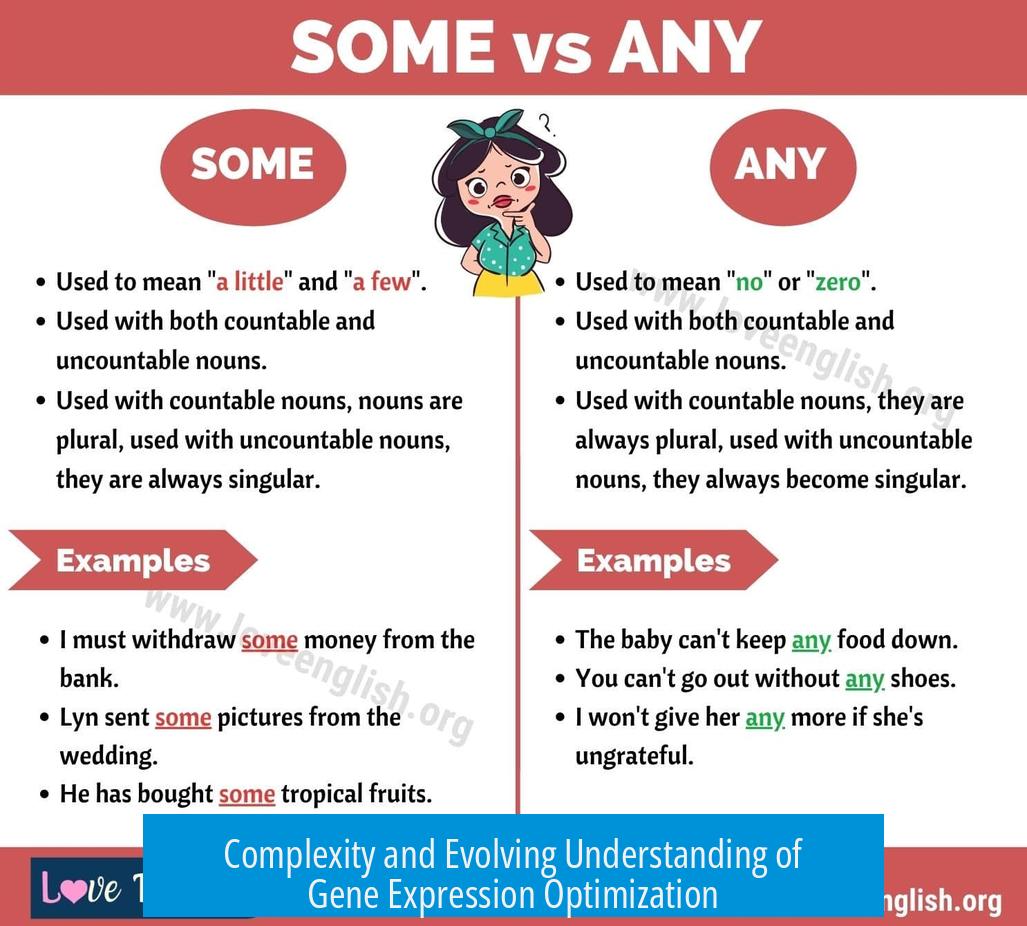
Designing synthetic genes for optimal protein production remains challenging. Protein output depends on multiple intertwined factors including mRNA stability, transcription rates, and translation efficiency. Natural genes exhibit a balanced interplay of these elements shaped by evolution.
Genetic engineering tries to replicate this balance but is hindered by incomplete knowledge. Recent advances using high-throughput synthetic libraries and molecular techniques enhance our understanding. These efforts lead toward more reliable optimization approaches.
Additional Considerations in Codon Optimization Quality
Codon Optimization Is a Black Art
Many companies claim the superiority of their codon optimization methods. Often, the focus is on simplifying DNA synthesis, for example, by reducing repetitive sequences, rather than genuinely improving expression through biological principles.
This simplification can neglect important aspects like mRNA folding, transcription factor binding, or regulatory sequences. Consequently, codon optimization should be viewed critically rather than as a guaranteed solution.
Variation in Codon Optimality

Not all optimal codons contribute equally to gene expression. Studies show specific codons, such as ones coding for leucine, may have a larger effect on indices like codon adaptation or translational selection advantage than others (e.g., serine codons).
This suggests some “better” codons improve protein production more significantly, which adds another layer of complexity to optimization strategies.
Summary
- Codon-optimized genes vary in effectiveness because gene expression depends on more than codon frequency.
- Secondary mRNA structures, especially near the 5′ end, influence translation initiation and mRNA stability strongly.
- Transcriptional influences and unintended regulatory motifs within genes can alter expression unpredictably.
- CAI is insufficient alone; tRNA availability and codon context are better predictors.
- Many optimization services prioritize DNA synthesis ease rather than comprehensive gene expression factors.
- Some codons have greater selection advantage and impact than others, affecting optimization results.
- Understanding gene expression is evolving through high-throughput analysis and biomolecular studies.
Some Codon OP Genes Are Better Than Others? Let’s Crack This Genetic Puzzle!
Short answer: Yes, some codon-optimized genes truly are better than others. But don’t expect a simple recipe—there’s a complex dance involving mRNA structure, codon choice, and even DNA-level quirks.
Imagine ordering a codon-optimized gene from a biotech vendor. One might expect identical performance anywhere you go, right? Not quite. As one user shares, ordering codon-optimized genes for E. coli expression from GenScript gave satisfying results—but without side-by-side comparisons with other providers, that endorsement feels a bit shy.
Why is this? Well, the phrase “codon optimization” is often tossed around like it’s a magic wand. Yet, it’s a bit more like an intricate recipe with many secret ingredients. Some companies like GenScript claim to take secondary mRNA structure into account, not just swapping in the most frequent codons—adding layers to their approach. Others may focus mainly on the most common codons, perhaps easing synthesis but missing subtle expression boosts.
The Algorithm Race: What’s Under the Hood?

Different codon optimization providers employ diverse algorithms. GenScript’s reportedly superior because it factors in mRNA secondary structure, which shapes how long the mRNA lasts and how fast the ribosome translates it. Smaller competitors might focus primarily on codon frequency, avoiding “rare” codons but skipping the bigger picture.
But what’s so important about this mRNA secondary structure? Here’s the quick biology lesson: mRNA isn’t a simple string; it folds onto itself. Structures near the 5’ end, especially including untranslated regions (UTRs), heavily influence mRNA stability and translation efficiency. The Salis lab (check them out at https://salislab.net/software/) showcases how RNA structures at this end affect protein production far more than codon rarity alone.
Beyond Codons: The Whole Genetic Orchestra
Interestingly, it’s not just about codons or mRNA folding. Transcriptional-level complexities also sneak into the picture. Sometimes, parts of the DNA sequence might bind repressors or other proteins that slow or stop transcription—something rare optimization tools check for. So even a perfectly optimized codon set can underperform if hidden regulatory elements interfere.
Plus, the traditional metric of codon usage like the Codon Adaptation Index (CAI) misses part of the story. While CAI aims to reflect how well a gene matches the host’s codon frequency, it doesn’t consider tRNA availability—the real workforce the ribosome taps to make proteins. Years ago, research from DNA2.0 pointed out tRNA pool sizes as a better predictor of translation efficiency. So, a beautifully optimized sequence with “common” codons might still drag if those codons don’t match abundant tRNAs.
Okay, but Are All Optimal Codons Created Equal?
Turns out, no. Even among frequently used codons, some pull heavier weight than others. Take leucine and serine codons: leucine codons tend to influence codon usage measures more significantly than serine’s. This suggests that some codons are “more optimal,” providing greater evolutionary selection advantages and presumably better translation performance. Engineers and scientists leverage this subtlety to fine-tune gene designs.
The Challenge of Synthetic Gene Design
Here’s the kicker: natural genes have balanced multiple factors for millions of years. Evolution polished their sequences for optimal performance in their native context. Synthetic genes? Much less so. We’re still figuring out how to juggle transcription, mRNA decay, and translation factors simultaneously.
Recent advances using high-throughput gene libraries and cutting-edge biomolecular tools are pushing this frontier. These studies reveal how tweaks to sequence elements can dramatically alter protein yields. With tools like those from the Salis lab and beyond, designing a gene with balanced codon usage, mRNA structure, and regulatory feature avoidance is becoming more science than guesswork.
What Does This Mean For You?
- Choosing codon optimization providers isn’t just shopping for the cheapest. Look for those incorporating secondary mRNA structure and other regulatory insights in their algorithms.
- Beware of companies that optimize merely for synthesis ease or codon frequency. That’s the bare minimum.
- If possible, test multiple providers and sequences experimentally—because algorithms can only predict so much.
- Consider tRNA abundance and mRNA folding especially near gene starts.
- Stay updated on emerging tools that analyze transcription factor binding sites and mRNA stability influencers.
Personal Note from the Lab Bench
Back when I first dipped my toes into ordering codon-optimized genes, I thought any company could just “optimize” and be done with it. Years later, after seeing some proteins sparkle in abundance and others sputter despite similar codon frequencies, I learned that codon optimization is both art and science. Sometimes it feels like tuning a vintage car engine: a tweak here, a twist there, and sometimes, just a gut feeling guides you.
Final Thoughts: The GenScript Advantage?
GenScript stands out with a comprehensive algorithm that factors more than just codon frequency. Their emphasis on mRNA secondary structures and purported patented techniques might give their optimized sequences an edge, especially in tricky expression systems like E. coli. Yet, as users note, full comparisons with other vendors like IDT, Thermo, GeneWiz, or newcomers like Atum will provide clearer verdicts.
Remember, optimizing gene expression isn’t a one-size-fits-all game. The nuanced interplay of codon usage, RNA folding, transcription interference, and host context means your best “codon op gene” might depend on multiple factors. So next time you order a codon-optimized construct, ask: are they just swapping codons, or are they sculpting the whole genetic symphony?
In sum, some codon-optimized genes are definitely better than others, thanks to diverse algorithms handling secondary structures, tRNA pools, and beyond. The gene expression world is complex—and that complexity means that care, testing, and up-to-date methods rule the day. It’s a thrilling frontier for genetic engineers and curious minds alike.
What makes some codon-optimized genes perform better than others?
Different gene synthesis providers use unique algorithms. Some consider mRNA secondary structure, not just common codons. This can lead to differences in how well the gene expresses protein.
How does mRNA secondary structure affect gene expression?
Secondary structure, especially near the 5′ end, impacts mRNA stability and translation. Strong structures can block ribosome access and lower protein production.
Is codon usage frequency the best way to optimize genes?
Not always. Codon Adaptation Index (CAI) often fails to predict expression levels accurately. tRNA availability and mRNA structure play bigger roles.
Can transcription factors influence gene expression besides codon usage?
Yes. Repressors or other DNA-binding proteins may interact with gene sequences. This can affect transcription and is rarely accounted for in simple codon optimization.
Why is gene expression optimization described as difficult?
Protein production depends on multiple intertwined factors: codon choice, mRNA decay, transcription, and more. Natural genes evolve balanced designs, but synthetic genes face limitations in design knowledge.
Are all optimal codons equally effective?
No. Some codons, like certain leucine codons, provide more advantage in translation efficiency than others, such as serine codons. Not all “optimal” codons contribute equally.


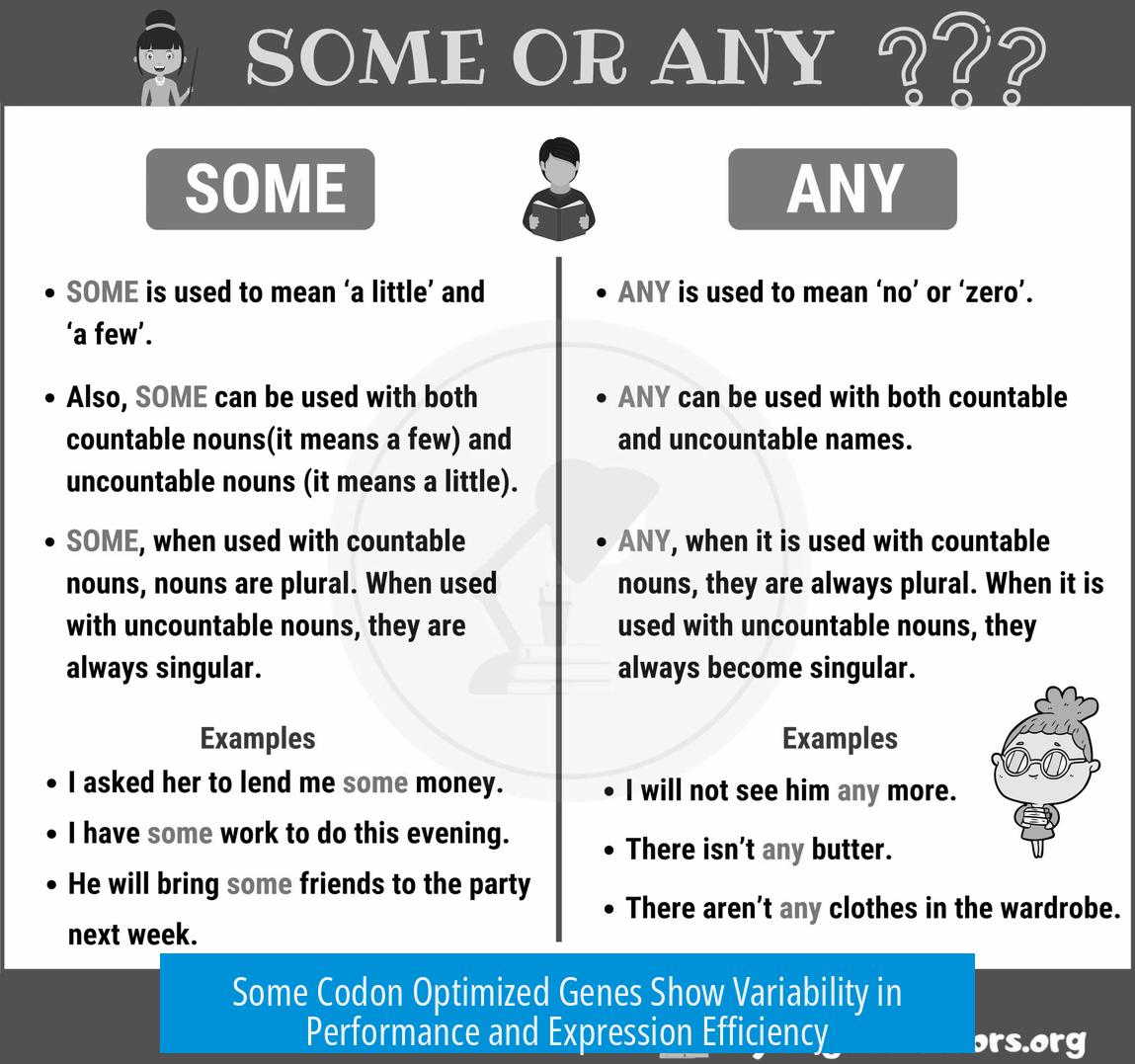
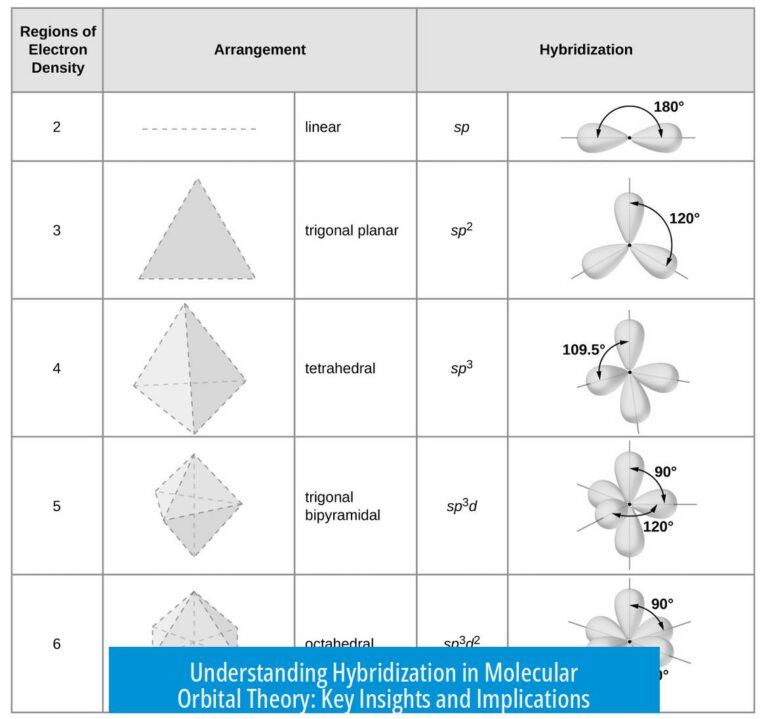
Leave a Comment